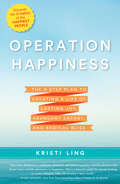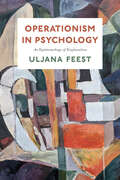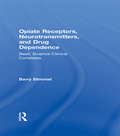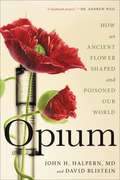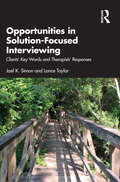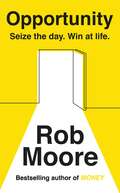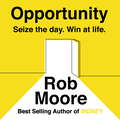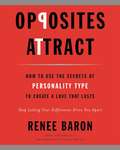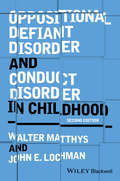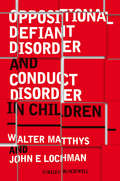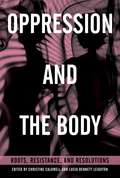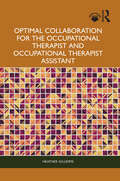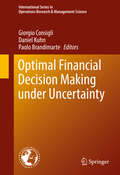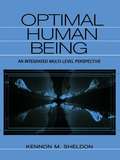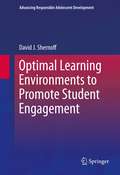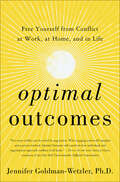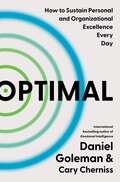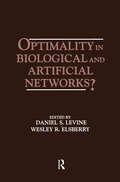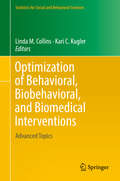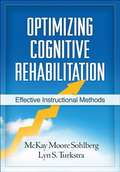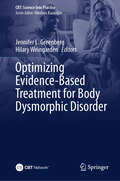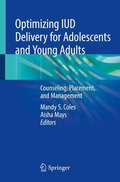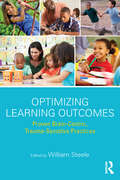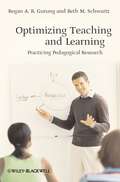- Table View
- List View
Operation Happiness: The 3-Step Plan to Creating a Life of Lasting Joy, Abundant Energy, and Radical Bliss
by Kristi LingIn Operation Happiness, happiness strategist and life coach Kristi Ling teaches you how to create immediate, positive shifts in your life by proving that happiness is a skill that can be cultivated, learned, and mastered--much like playing an instrument. After experiencing a long-term illness, a divorce, and the sudden deaths of loved ones, Ling spent years studying the science of happiness. She focused on identifying and testing specific emotional support tools. During this process, she discovered something that goes against everything we've been lead to believe about happiness: it isn't just something you feel; it's something you do. Based on this discovery, Ling outlines the three foundational principles that lead to a life of joy: Change Your View, Make Over Your Mornings, and Create New Habits.Part memoir and part how-to guide, Operation Happiness combines compelling personal stories, inspiring perspective shifts, and clear actionable steps to help you create a solid foundation for sustainable happiness that will propel you into a new, light-filled way of living.
Operationism in Psychology: An Epistemology of Exploration
by Uljana FeestAnalyzes psychological research to offer insights into how methodological and ontological questions are intertwined. Psychology has seen an intense debate about the lack of replicability of results in recent years. Uljana Feest uses history and philosophy of science to shed light on the nature of experiment in psychology in general, but her aim reaches beyond debates about replication to provide a novel and comprehensive analysis of the investigative process in experimental psychology. She shows that the central unit of analysis for our epistemological considerations of psychological research should be not theories but, rather, concepts. Her guiding question is: How do psychological concepts figure in the experimental exploration of the objects of psychological research? For Feest, this question has two intertwined aspects: What role do concepts play in the design of experiments and the production of data, and how can concepts be revised or adapted in response to experimental results. Following the historical trajectory of debates about operationism in psychology, she argues that this debate was not concerned with philosophical theories of meaning but, instead, closely connected to the investigative practices of experimental psychologists. The book offers a broad analytical framework for thinking philosophically about the investigative process in psychology, including analyses of the relationship between data and phenomena in psychology, the relationship between folk- and scientific psychological concepts, the relationship between genuine results and experimental artifacts, and the nature and exploration of psychological kinds.
Opiate Receptors, Neurotransmitters, and Drug Dependence: Basic Science-Clinical Correlates
by Barry StimmelExperts address the role of neuromodulators and opiate receptors in alcohol and drug dependence. They present innovative research techniques, new discoveries, and possible clinical correlates that allow for a much greater understanding of the clinical phenomena surrounding alcohol and narcotic use. Included in this thought-provoking volume are a comprehensive review of the current knowledge of the endogenous opiates, their interactions with the opiate receptors, and the potential relationship that these substances might have in promoting the development of dependence, tolerance, and withdrawal; the translation of the basic physiologic findings occuring during withdrawal to treatment of withdrawal symptoms in the clinical setting; and a physiological explanation for the rationale of using clonidine and naltrexone to accelaerate the detoxification process without undue discomfort.
Opium: How an Ancient Flower Shaped and Poisoned Our World
by David Blistein John H. Halpern"A landmark project." -- Dr. Andrew Weil"Engrossing and highly readable." -- Sam Quinones"An astonishing journey through time and space." -- Julie Holland, MD"The most important, provocative, and challenging book I've read in a long time." -- Laurence BergreenFrom a psychiatrist on the frontlines of addiction medicine and an expert on the history of drug use, comes the "authoritative, engaging, and accessible" (Booklist) history of the flower that helped to build -- and now threatens -- modern society.Opioid addiction is fast becoming the most deadly crisis in American history. In 2018, it claimed nearly fifty thousand lives -- more than gunshots and car crashes combined, and almost as many Americans as were killed in the entire Vietnam War. But even as the overdose crisis ravages our nation -- straining our prison system, dividing families, and defying virtually every legislative solution to treat it -- few understand how it came to be. Opium tells the extraordinary and at times harrowing tale of how we arrived at today's crisis, "mak[ing] timely and startling connections among painkillers, politics, finance, and society" (Laurence Bergreen). The story begins with the discovery of poppy artifacts in ancient Mesopotamia, and goes on to explore how Greek physicians and obscure chemists discovered opium's effects and refined its power, how colonial empires marketed it around the world, and eventually how international drug companies developed a range of powerful synthetic opioids that led to an epidemic of addiction. Throughout, Dr. John Halpern and David Blistein reveal the fascinating role that opium has played in building our modern world, from trade networks to medical protocols to drug enforcement policies. Most importantly, they disentangle how crucial misjudgments, patterns of greed, and racial stereotypes served to transform one of nature's most effective painkillers into a source of unspeakable pain -- and how, using the insights of history, state-of-the-art science, and a compassionate approach to the illness of addiction, we can overcome today's overdose epidemic. This urgent and masterfully woven narrative tells an epic story of how one beautiful flower became the fascination of leaders, tycoons, and nations through the centuries and in their hands exposed the fragility of our civilization.
Opportunities in Solution-Focused Interviewing: Clients’ Key Words and Therapists’ Responses
by Lance Taylor Joel K. SimonWritten by the developers of the microanalysis of opportunities approach, this book describes how clinicians can use this model when listening and responding to clients in solution-focused therapy, training, coaching, and supervision. Joel K. Simon and Lance Taylor begin by reviewing the evolution, philosophical foundations, and intervention tools of solution-focused brief therapy, sharing how their practice has evolved over time from their clinical experience with clients, trainees, supervisees, and colleagues. Moving from theory to practice, the book then explores microanalysis of opportunities, beginning with how the authors developed the approach and created the process. Replete with actual examples of conversations between clients and therapists, and between trainer and trainee, the book demonstrates how the model can be applied in practice with analyses and discussions about analyzed material throughout. It displays the application of the approach to coaching, supervision, and training. This valuable book will not only be useful to therapists new to solution-focused brief therapy, but also to those who are experienced solution-focused practitioners. Psychotherapists, clinical social workers, counselors, and other mental health professionals will find this an illuminating read.
Opportunity: Seize The Day. Win At Life.
by Rob MooreOpportunities are limitless and abundant.The problem is, many people can't recognise them.It can feel like opportunity doesn't knock for you, or other people get more opportunities, or you have bad luck and timing.You just need to know where to look. How to ask. When to ACT.Opportunity can be a window or a door; sometimes it opens right in front of you and sometimes it knocks. You need to be ready: windows, doors and eyes open.Are you waiting for that once-in-a-lifetime or business opportunity to change your life? How will you know when it comes? How will you be sure it's right for you?This book is not about waiting for an opportunity. It's a book containing strategies that can be employed immediately, ensuring you attract opportunities abundantly, both big and small, and you're ready to recognise and take them. To turn ideas into opportunities. Successful people often make their own luck - they find success because they have trained their minds to recognise great opportunities and make the most of them, rather than freezing with uncertainty or lacking the vision to see them through. They know the opportunity cost of not taking them.In this book you'll learn how to spot, seize and implement the right opportunities, and how to say NO to the wrong ones. You'll learn to take fast and slow opportunities. When opportunity appears you'll be ready to take advantage, seize the day, and win at life.
Opportunity: Seize The Day. Win At Life.
by Rob MooreOpportunities are limitless and abundant.The problem is, many people can't recognise them.It can feel like opportunity doesn't knock for you, or other people get more opportunities, or you have bad luck and timing.You just need to know where to look. How to ask. When to ACT.Opportunity can be a window or a door; sometimes it opens right in front of you and sometimes it knocks. You need to be ready: windows, doors and eyes open.Are you waiting for that once-in-a-lifetime or business opportunity to change your life? How will you know when it comes? How will you be sure it's right for you?This book is not about waiting for an opportunity. It's a book containing strategies that can be employed immediately, ensuring you attract opportunities abundantly, both big and small, and you're ready to recognise and take them. To turn ideas into opportunities. Successful people often make their own luck - they find success because they have trained their minds to recognise great opportunities and make the most of them, rather than freezing with uncertainty or lacking the vision to see them through. They know the opportunity cost of not taking them.In this book you'll learn how to spot, seize and implement the right opportunities, and how to say NO to the wrong ones. You'll learn to take fast and slow opportunities. When opportunity appears you'll be ready to take advantage, seize the day, and win at life.
Opportunity: Seize The Day. Win At Life.
by Rob MooreSuccess is all about spotting opportunities, acting with purpose, and taking advantage. This audiobook will ensure you're flexible, prepared and ready to win, when it counts.Are you waiting for that once-in-a-lifetime opportunity to change your life, change your business or change the world? How will you know when it comes? How will you be sure you're ready?This book is not about waiting for an opportunity that might never come. It's a book for right now containing ideas and strategies that can be employed right away, and will ensure that you attract opportunities, whether big or small, all the time. Successful people are sometimes lucky - but most of all they find success because they have trained their minds to identify great opportunities and make the most of them when they arrive, rather than freezing with uncertainty or lacking the vision to see them through. In this book Rob Moore, the bestselling author of MONEY, START NOW. GET PERFECT LATER and I'M WORTH MORE shows you how to elevate your emotional intelligence and decision making to ensure that when opportunity strikes you are ready to take advantage, seize the day, and win at life.When Opportunity knocks, you'll be ready.(P)2021 Hodder & Stoughton Limited
Opposites Attract
by Renee BaronDoes your partner want to go out on Friday nights when you prefer to curl up at home with a movie? Does your neat-freak boyfriend always want to clean up your cluttered office? Does your wife want to plan trips six months in advance while you're a fly-by-the-seat-of-your-pants kind of person? The truth is, opposites attract. People who are different from each other in fundamental ways often catch each other's attention. We are attracted to the very qualities we wish we had ourselves. A shy person looks for a mate who is outgoing and gregarious to provide a social circle, and the outgoing person may need to be with someone who won't compete with him for attention. It seems like the perfect match-that is, until those very differences that originally attracted us start to drive us crazy. But these differences don't have to drive couples apart. Renee Baron, a marriage and family therapist with more than twenty-five years of experience, uses the Myers-Briggs Type Indicator to provide a practical program for learning to appreciate our differences, rather than fight over them. The MBTI is the most widely used personality indicator in the world. By discovering your innate personality preferences and those of your partner, you can stop having the same fights over and over again and start appreciating the gifts each of you offers to the relationship.
Oppositional Defiant Disorder and Conduct Disorder in Childhood
by Walter Matthys Lochman John ENewly updated, this is a comprehensive guide to ODD and conduct disorder (CD) in children aged 3-14 for professionals, students, and researchers. Summarizes the most important empirical knowledge across a broad array of topics, with a focus on the latest research and meta-analyses, as well as high-quality older studies Includes revised diagnostic conceptualizations for ODD and CD from DSM-V and the upcoming ICD-11 classification systems, with particular attention to similarities, differences, and information about an angry-irritable subtype for ODD Provides updated reviews of biological and social-cognitive risk and protective factors and the evidence base for relevant treatment and prevention procedures Describes best practices for assessment, treatment, and prevention for children and their families, based on the clinical and research work of the well-respected author team
Oppositional Defiant Disorder and Conduct Disorder in Children
by Walter Matthys Lochman John EA concise and accessible exploration of cutting-edge literature of the risk factors contributing to the development of ODD and CD, primarily in pre-school and primary children.Precise, focused and up-to-date overview of Oppositional Defiant Disorder and Conduct Disorder LiteraturePresents assessment methods and evidence-based intervention strategiesWell-known and prolific authoring team
Oppression and the Body: Roots, Resistance, and Resolutions
by Christine Caldwell Lucia Bennett LeightonA timely anthology that explores power, privilege, and oppression and their relationship to marginalized bodies Asserting that the body is the main site of oppression in Western society, the contributors to this pioneering volume explore the complex issue of embodiment and how it relates to social inclusion and marginalization. In a culture where bodies of people who are brown, black, female, transgender, disabled, fat, or queer are often shamed, sexualized, ignored, and oppressed, what does it mean to live in a marginalized body? Through theory, personal narrative, and artistic expression, this anthology explores how power, privilege, oppression, and attempted disembodiment play out on the bodies of disparaged individuals and what happens when the body’s expression is stereotyped and stunted. Bringing together a range of voices, this book offers strategies and practices for embodiment and activism and considers what it means to be an embodied ally to anyone experiencing bodily oppression.
Optimal Collaboration for the Occupational Therapist and Occupational Therapist Assistant
by Heather GillespieThis book acts as a guide for occupational therapists to develop and continually evaluate trusting working relationships with occupational therapist assistants (OTAs), resulting in more effective occupational therapy service delivery to clients. To combat the misunderstandings between occupational therapists and OTAs, this book provides theoretical knowledge, practical learning, and case study examples to guide and develop positive working relationships between occupational therapists and OTAs. The importance of developing this trusting intraprofessional relationship is discussed in detail, and recommended approaches are reviewed. Described methodologies can be utilized to determine appropriate involvement of OTAs in specific client treatments, allowing for a consistent and effective synergy within occupational therapy. This book is an ideal read for occupational therapist students and occupational therapists currently working in a clinical practice setting, as well as for rehabilitation managers and employers. It is also a beneficial resource for OTA students and OTAs working within the profession.
Optimal Financial Decision Making under Uncertainty
by Daniel Kuhn Giorgio Consigli Paolo BrandimarteThe scope of this volume is primarily to analyze from different methodological perspectives similar valuation and optimization problems arising in financial applications, aimed at facilitating a theoretical and computational integration between methods largely regarded as alternatives. Increasingly in recent years, financial management problems such as strategic asset allocation, asset-liability management, as well as asset pricing problems, have been presented in the literature adopting formulation and solution approaches rooted in stochastic programming, robust optimization, stochastic dynamic programming (including approximate SDP) methods, as well as policy rule optimization, heuristic approaches and others. The aim of the volume is to facilitate the comprehension of the modeling and methodological potentials of those methods, thus their common assumptions and peculiarities, relying on similar financial problems. The volume will address different valuation problems common in finance related to: asset pricing, optimal portfolio management, risk measurement, risk control and asset-liability management. The volume features chapters of theoretical and practical relevance clarifying recent advances in the associated applied field from different standpoints, relying on similar valuation problems and, as mentioned, facilitating a mutual and beneficial methodological and theoretical knowledge transfer. The distinctive aspects of the volume can be summarized as follows: Strong benchmarking philosophy, with contributors explicitly asked to underline current limits and desirable developments in their areas. Theoretical contributions, aimed at advancing the state-of-the-art in the given domain with a clear potential for applications The inclusion of an algorithmic-computational discussion of issues arising on similar valuation problems across different methods. Variety of applications: rarely is it possible within a single volume to consider and analyze different, and possibly competing, alternative optimization techniques applied to well-identified financial valuation problems. Clear definition of the current state-of-the-art in each methodological and applied area to facilitate future research directions.
Optimal Human Being: An Integrated Multi-level Perspective
by Kennon M. SheldonKen Sheldon's comprehensive new book addresses two questions: how can individuals best integrate the different facets of themselves to achieve "optimal human being", and how can researchers best integrate the different levels of analysis within the human sciences to understand "optimal human being" in general? In the process, the book supplies two new frameworks—one for viewing the human sciences as a group, and the other for viewing personality theory within that group. Optimal Human Being features a multi-level model that moves from biologically based levels of analysis to higher, socially based levels, and demonstrates how these different levels interact to determine behavior. The author then proposes a new way of looking at personality by examining four "tiers": organismic foundations, personality traits, goals/intentions, and self-concepts, and demonstrates how these levels relate to the state of optimal human being. The book concludes with two higher levels of analysis relevant to personality—social interaction and culture—and proposes a new profile of optimal human being.Intended for researchers and students in social and personality, clinical, developmental, and industrial psychology and other social sciences, the book will also serve as a supplement in a variety of courses including personality, positive psychology, well being, personal development, and motivation.
Optimal Learning Environments to Promote Student Engagement
by David J. ShernoffOptimal Learning Environments to Promote Student Engagement analyzes the psychological, social, and academic phenomena comprising engagement, framing it as critical to learning and development. Drawing on positive psychology, flow studies, and theories of motivation, the book conceptualizes engagement as a learning experience, explaining how it occurs (or not) and how schools can adapt to maximize it among adolescents. Examples of empirically supported environments promoting engagement are provided, representing alternative high schools, Montessori schools, and extracurricular programs. The book identifies key innovations including community-school partnerships, technology-supported learning, and the potential for engaging learning opportunities during an expanded school day. Among the topics covered: Engagement as a primary framework for understanding educational and motivational outcomes.Measuring the malleability, complexity, multidimensionality, and sources of engagement.The relationship between engagement and achievement.Supporting and challenging: the instructor's role in promoting engagement.Engagement within and beyond core academic subjects.Technological innovations on the engagement horizon. Optimal Learning Environments to Promote Student Engagement is an essential resource for researchers, professionals, and graduate students in child and school psychology; social work; educational psychology; positive psychology; family studies; and teaching/teacher education.
Optimal Outcomes: Free Yourself from Conflict at Work, at Home, and in Life
by Jennifer Goldman-Wetzler“This hands-on book is full of reflection exercises to help you spot the hidden patterns in your regular clashes and learn how to defuse them.” —Adam Grant, #1 New York Times–bestselling author A founding CEO and his top salesperson are engaged in a heated clash over her compensation package.A mother and daughter are locked in a nasty cycle of blame and attack.A high-profile executive team is struggling with aggressive political infighting.In all these cases, every effort to talk it out has been unsuccessful.Where can you turn when your attempts to resolve conflict fail? Most approaches emphasize collaboration. You are supposed to sit down, calmly talk through your differences, and find a solution. But what if nothing seems to work, no matter what you do?When situations resist resolution, the Optimal Outcomes Method teaches us conflict freedom.This innovative method is based on Dr. Jennifer Goldman-Wetzler’s training at the Program on Negotiation at Harvard Law School, two decades as a consultant to Fortune 500 and high-growth CEOs and senior teams, grassroots work with Middle East leaders, US government-funded research on terrorism, and her popular course at Columbia University. In Optimal Outcomes, she reveals eight groundbreaking practices proven to help people everywhere free themselves from conflict.With inspiring stories from clients, students, and Dr. Goldman-Wetzler’s own life lighting the way, you’ll learn to observe complex situations with clarity, access your shadow values (things you really care about but have been unwilling to admit), and take bold, simple, surprising action. Applying the practices, you’ll reach your Optimal Outcome—which may be vastly different from what you originally imagined, but more satisfying than you ever dreamed possible.
Optimal: How to Sustain Personal and Organizational Excellence Every Day
by Daniel Goleman Cary ChernissIn his groundbreaking #1 bestseller Emotional Intelligence, Daniel Goleman revolutionized how we think about intelligence. Now, he reveals practical methods for using these inner resources to more readily enter an optimal state of high performance and satisfaction while avoiding burnout. There are moments when we achieve peak performance: An athlete plays a perfect game; a business has a quarter with once-in-a-lifetime profits. But these moments are often elusive, and for every amazing day, we may have a hundred ordinary and even unsatisfying days. Fulfillment doesn’t come from isolated peak experiences, but rather from many consistent good days. So how do we sustain performance, while avoiding burnout and maintaining balance? In Optimal, Daniel Goleman and Cary Cherniss reveal how emotional intelligence can help us have a great day, any day. They explain how to set a realistic, attainable goal of feeling satisfied that you’ve had a productive day — to consistently work at your ‘optimal’ level. Based on research of how hundreds of people build the inner architecture of having a good day, they sketch what an optimal state feels like, and show how emotional intelligence holds the key to our best performance.Optimal is the culmination of decades of scientific discoveries bearing on emotional intelligence. Enhanced emotional intelligence pays off in improved engagement, productivity, and more satisfying days. In this book, you’ll find the keys to competence in emotional intelligence, and practical methods for applying this skill set more readily. It will equip you to become a highly effective leader and enable you to build an organizational culture that empowers workers to sustain high performance.
Optimality in Biological and Artificial Networks? (INNS Series of Texts, Monographs, and Proceedings Series)
by Daniel S. Levine Wesley R. ElsberryThis book is the third in a series based on conferences sponsored by the Metroplex Institute for Neural Dynamics, an interdisciplinary organization of neural network professionals in academia and industry. The topics selected are of broad interest to both those interested in designing machines to perform intelligent functions and those interested in studying how these functions are actually performed by living organisms and generate discussion of basic and controversial issues in the study of mind. The topic of optimality was chosen because it has provoked considerable discussion and controversy in many different academic fields. There are several aspects to the issue of optimality. First, is it true that actual behavior and cognitive functions of living animals, including humans, can be considered as optimal in some sense? Second, what is the utility function for biological organisms, if any, and can it be described mathematically? Rather than organize the chapters on a "biological versus artificial" basis or by what stance they took on optimality, it seemed more natural to organize them either by what level of questions they posed or by what intelligent functions they dealt with. The book begins with some general frameworks for discussing optimality, or the lack of it, in biological or artificial systems. The next set of chapters deals with some general mathematical and computational theories that help to clarify what the notion of optimality might entail in specific classes of networks. The final section deals with optimality in the context of many different high-level issues, including exploring one's environment, understanding mental illness, linguistic communication, and social organization. The diversity of topics covered in this book is designed to stimulate interdisciplinary thinking and speculation about deep problems in intelligent system organization.
Optimization of Behavioral, Biobehavioral, and Biomedical Interventions: Advanced Topics (Statistics for Social and Behavioral Sciences)
by Linda M. Collins Kari C. KuglerBehavioral, biobehavioral, and biomedical interventions are programs with the objective of improving and maintaining human health and well-being, broadly defined, in individuals, families, schools, organizations, or communities. These interventions may be aimed at, for example, preventing or treating disease, promoting physical and mental health, preventing violence, or improving academic achievement. This book provides additional information on a principled empirical framework for developing interventions that are more effective, efficient, economical, and scalable. This framework is introduced in the monograph, "Optimization of Behavioral, Biobehavioral, and Biomedical Interventions: The Multiphase Optimization Strategy (MOST)" by Linda M. Collins (Springer, 2018). The present book is focused on advanced topics related to MOST. The chapters, all written by experts, are devoted to topics ranging from experimental design and data analysis to development of a conceptual model and implementation of a complex experiment in the field. Intervention scientists who are preparing to apply MOST will find this book an important reference and guide for their research. Fields to which this work pertains include public health (medicine, nursing, health economics, implementation sciences), behavioral sciences (psychology, criminal justice), statistics, and education.
Optimizing Cognitive Rehabilitation
by Lyn Turkstra Mckay SohlbergRehabilitation professionals face a key challenge when working with clients with acquired cognitive impairments: how to teach new skills to individuals who have difficulty learning. Unique in its focus, this book presents evidence-based instructional methods specifically designed to help this population learn more efficiently. The expert authors show how to develop, implement, and evaluate an individualized training plan. They provide practical guidelines for teaching multistep procedures, cognitive strategies, the use of external aids, and more. User-friendly features include 17 sample worksheets and forms; blank forms can be downloaded and printed in a convenient 8 1/2" x 11" size.
Optimizing Evidence-Based Treatment for Body Dysmorphic Disorder (CBT: Science Into Practice)
by Jennifer L. Greenberg Hilary WeingardenThis book provides an understanding of body dysmorphic disorder (BDD), a psychiatric classification that is characterized by a preoccupation with a perceived or slight imperfection in physical appearance. This disorder lowers quality of life due to time-consuming compulsions intended to hide, fix, or check appearance concerns. Although relatively common, BDD is often not treated appropriately. When untreated, BDD is chronic, severe, and associated with substantial psychosocial impairment and morbidity, including unemployment rates of roughly 40-50%, suicide attempts in 22-28%, and lifetime housebound rates of roughly 30%.This book provides an overview of body dysmorphic disorder (BDD), a psychiatric classification that is characterized by excessively impaired perception of physical attributes that can lead to acute disruption of life activities. BDD is a common disorder, but few clinicians are trained in its assessment and treatment. This volume provides an evidence-based review of the literature for a greater understanding of the nature of the disorder. Most important, it demonstrates how to effectively assess and treat BDD. Evidence-based psychological and pharmacological treatments are presented, and importantly, ineffective treatments are also reviewed. To optimize CBT for BDD, guidelines are provided to address the most common challenges in diagnosis and treatment, including common comorbidities, differential diagnoses with similar disorders, safety management, addressing low insight or motivation, and modifying treatment for special populations including youth, patients from under-represented backgrounds, and BDD variants. Case examples throughout illuminate for practitioners the theoretical and clinical aspects of this complex problem. This an essential volume for practitioners and clinicians-in-training for gaining perspective on the disorder and its efficacious treatment. “Integrating research and clinical wisdom of some of the world's leading BDD experts, this book comprehensively covers the foundational as well as more nuanced approaches to treatment. Clinicians from all experience and skill levels who treat BDD will find this book to be a go-to guide to delivering high quality, evidence-based, and individually tailored care.” Jamie Feusner, MD Professor of Psychiatry, University of Toronto
Optimizing IUD Delivery for Adolescents and Young Adults: Counseling, Placement, and Management
by Mandy S. Coles Aisha MaysMany individuals worldwide initiate sexual activity during their adolescent and young adult (AYA) years and are in need of safe and effective contraceptive services. Because of their safety profile, ease of use, and privacy many international professional organizations recommend that long-acting reversible contraception (LARC), including intrauterine devices (IUDs), be included in contraception discussions with AYAs. IUDs are particularly advantageous because these methods are safe and highly effective (>99% efficacy), are easier to keep confidential because they are often undetectable to others, and do not require daily adherence or frequent visits for refills. Despite significant evidence of their safety, acceptability, and effectiveness among adolescents and AYAs, IUDs remain underutilized in this population. Written by experts in the field, Optimizing IUD Delivery for Adolescents and Young Adults provides a comprehensive framework that examines the history of IUDs, counseling, initiation, placement, and follow-up techniques that are unique to AYA populations. The text closes with resource chapters, including, expert clinical pearls for AYA IUD delivery, how to access IUD training, and information on IUD billing and reimbursement. In an effort to integrate the voice of youth, clinical case examples and patient stories are utilized throughout to provide both a clinical grounding for each chapter and context within which to apply the chapter material.
Optimizing Learning Outcomes: Proven Brain-Centric, Trauma-Sensitive Practices
by William SteeleOptimizing Learning Outcomes provides answers for the most pressing questions that mental health professionals, teachers, and administrators are facing in today’s schools. Chapters provide a wide array of evidence-based resources—including links to video segments—that promote understanding, discussion, and successful modeling. Accessible how-to trainings provide readers with multiple sensory-based practices that improve academic success and promote behavioral regulation. Clinicians and educators will come away from this book with a variety of tools for facilitating brain-based, trauma-sensitive learning for all, realizing improved learning outcomes, improving teacher satisfaction, and reducing disciplinary actions and suspensions.
Optimizing Teaching and Learning: Practicing Pedagogical Research
by Beth M. Schwartz Regan A. GurungThe scholarship of teaching and learning (SoTL) is one of the most dynamic areas of research in the field of higher education today in which faculty continuously evaluate the quality of their teaching and its affect on student learning. Faculty are being held accountable for the effectiveness of their teaching and in turn they are starting to engage in SoTL-related intellectual exchanges not only in their research agendas but also in the ways in which they teach their students in the classroom. At the heart of this new movement, there is a simple idea: take a close look at how you teach and how your students learn, use the same methodology that you would use for formal investigations (be it in the humanities or sciences), and hold your research to the same standards most notably peer review. Optimizing Teaching and Learning will serve as a guide for anyone who is interested in improving their teaching, the learning of their students, and at the same time contribute to the scholarship of teaching and learning. It bridges the gap between the research and practice of SoTL, with explicit instructions on how to design, conduct, analyze, and write-up pedagogical research, including samples of actual questionnaires and other materials (e.g., focus group questions) that will jumpstart investigations into teaching and learning. It also explores the advantages and disadvantages of various pedagogical practices and present applications of SoTL using case studies from a variety of disciplines. This book will serve as an invaluable resource for both seasoned faculty and new faculty who are just beginning to assess their teaching methods and learn how to think beyond the content.
